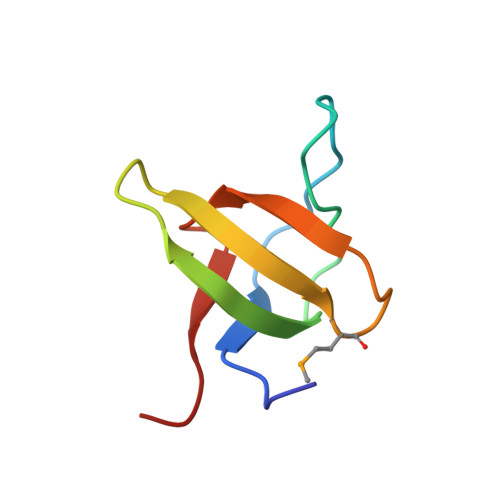A unique set of SH3-SH3 interactions controls IB1 homodimerization
Kristensen, O., Guenat, S., Dar, I., Allaman-Pillet, N., Abderrahmani, A., Ferdaoussi, M., Roduit, R., Maurer, F., Beckmann, J.S., Kastrup, J.S., Gajhede, M., Bonny, C.(2006) EMBO J 25: 785-797
- PubMed: 16456539
- DOI: https://doi.org/10.1038/sj.emboj.7600982
- Primary Citation of Related Structures:
2FPD, 2FPE, 2FPF - PubMed Abstract:
Islet-brain 1 (IB1 or JIP-1) is a scaffold protein that interacts with components of the c-Jun N-terminal kinase (JNK) signal-transduction pathway. IB1 is expressed at high levels in neurons and in pancreatic beta-cells, where it controls expression of several insulin-secretory components and secretion. IB1 has been shown to homodimerize, but neither the molecular mechanisms nor the function of dimerization have yet been characterized. Here, we show that IB1 homodimerizes through a novel and unique set of Src homology 3 (SH3)-SH3 interactions. X-ray crystallography studies show that the dimer interface covers a region usually engaged in PxxP-mediated ligand recognition, even though the IB1 SH3 domain lacks this motif. The highly stable IB1 homodimer can be significantly destabilized in vitro by three individual point mutations directed against key residues involved in dimerization. Each mutation reduces IB1-dependent basal JNK activity in 293T cells. Impaired dimerization also results in a reduction in glucose transporter type 2 expression and in glucose-dependent insulin secretion in pancreatic beta-cells. Taken together, these results indicate that IB1 homodimerization through its SH3 domain has pleiotropic effects including regulation of the insulin secretion process.
Organizational Affiliation:
Biostructural Research, Department of Medicinal Chemistry, The Danish University of Pharmaceutical Sciences, Copenhagen, Denmark. ok@dfuni.dk


















